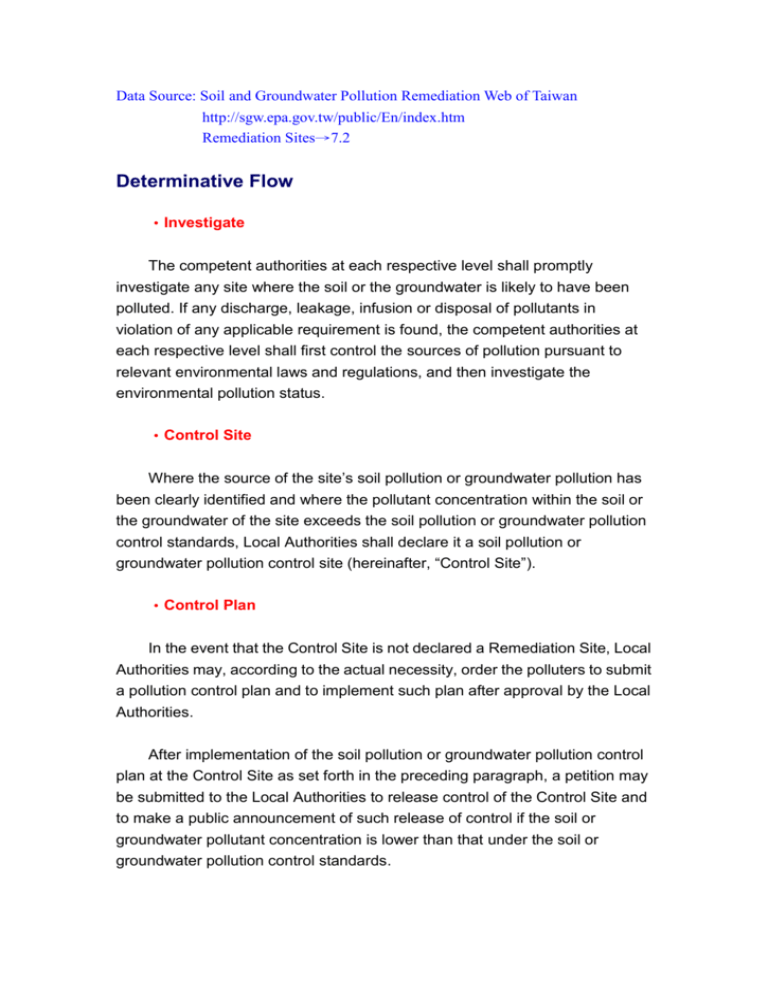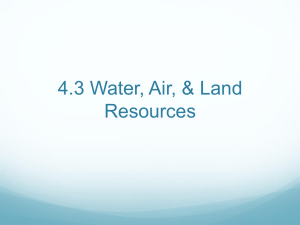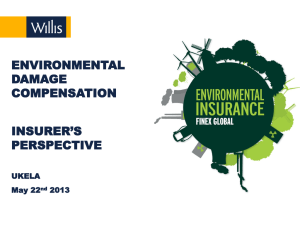Determinative Flow
advertisement

Data Source: Soil and Groundwater Pollution Remediation Web of Taiwan http://sgw.epa.gov.tw/public/En/index.htm Remediation Sites→7.2 Determinative Flow ‧Investigate The competent authorities at each respective level shall promptly investigate any site where the soil or the groundwater is likely to have been polluted. If any discharge, leakage, infusion or disposal of pollutants in violation of any applicable requirement is found, the competent authorities at each respective level shall first control the sources of pollution pursuant to relevant environmental laws and regulations, and then investigate the environmental pollution status. ‧Control Site Where the source of the site’s soil pollution or groundwater pollution has been clearly identified and where the pollutant concentration within the soil or the groundwater of the site exceeds the soil pollution or groundwater pollution control standards, Local Authorities shall declare it a soil pollution or groundwater pollution control site (hereinafter, “Control Site”). ‧Control Plan In the event that the Control Site is not declared a Remediation Site, Local Authorities may, according to the actual necessity, order the polluters to submit a pollution control plan and to implement such plan after approval by the Local Authorities. After implementation of the soil pollution or groundwater pollution control plan at the Control Site as set forth in the preceding paragraph, a petition may be submitted to the Local Authorities to release control of the Control Site and to make a public announcement of such release of control if the soil or groundwater pollutant concentration is lower than that under the soil or groundwater pollution control standards. ‧Remediation Site When the Control Site has been preliminarily assessed as having a likelihood that it may endanger national health and living environment, Local Authorities shall report to the central competent authority and request the central competent authority to appraise and declare the site as a soil pollution or groundwater pollution remediation site (hereinafter, “Remediation Site”). Local Authorities shall subsequently prepare a list of the designated Remediation Sites within seven days of the public declaration by the central competent authority and deliver the same to the governments of municipalities, and to the hsien (or city) governments, village (or township or districts) and land registration authorities for the public’s information. ‧Remediation Plan The polluter of the Remediation Site shall establish a soil pollution or groundwater pollution remediation plan in accordance with the results of the investigation and assessment set forth in Article 12, and implement such a plan after approval by Local Authorities. Local Authorities shall report said soil pollution or groundwater pollution remediation plan so approved to the central competent authority for reference and publish the highlights of the plan and review conclusions. If the polluter of the Remediation Site set forth in the preceding paragraph is unknown or fails to comply with the provisions of the preceding paragraph, Local Authorities may establish a soil pollution or groundwater pollution remediation plan for purposes of reducing the pollution and preventing dangers to the national health and living environment in accordance with the results of the investigation and assessment and the degree and order for handling as set forth in Article 12, depending on the financial condition of the Local Authorities, the technical feasibility of the remediation and the actual conditions of the Site, and implement such a plan after the approval of the competent central authority. Local Authorities shall publish the highlights of the plan and the review conclusions. The interested persons of the polluted land may establish a remediation plan before the Local Authorities proceed with the soil pollution and groundwater pollution remediation, and the procedure set forth in paragraph 1 shall apply mutatis mutandis. During the implementation of the soil pollution and groundwater pollution remediation plans, the persons implementing such plans may file an application to modify the remediation plans pursuant to the procedures set forth in Paragraphs 1 and 2. The Local Authorities may modify on its own or cause the persons who implement the remediation plans to modify the remediation plans according to the necessities of the actual circumstances. When there is more than one polluter or more than one interested person of the polluted land, they may jointly submit a soil pollution or groundwater pollution remediation plan. The cost spent by the competent authorities at each respective level for establishing, reviewing, implementing, modifying, and supervising soil pollution and groundwater pollution remediation plans pursuant to Paragraphs 2, and 4 may be defrayed by the Soil Pollution and Groundwater Pollution Remediation Fund. ‧Usage Restriction Region When the competent authority investigates the site under Paragraph 1 of Article 11, if the groundwater pollution concentration at the site exceeds groundwater pollution control standards, but the pollution source is still not confirmed, Local Authorities shall declare and designate a groundwater usage restriction region and other restrictions and shall take the necessary emergency measures pursuant to Article 13. ‧Necessary Emergency Measures Local Authorities shall take the following necessary emergency measures based on the actual condition of the Control Site or the Remediation Site to reduce the pollution hazard or prevent the aggravation of pollution: 1. ordering the polluter to stop any action or operation or to stop work in whole or in part; 2. investigating the groundwater pollution status pursuant to the Water Pollution Control Act and pursuing the persons liable for the pollution; if necessary, informing the residents to stop the use of groundwater or other polluted water sources, and restricting the digging of wells to obtain groundwater; 3. providing necessary alternative drinking water or notifying tap water authorities to connect tap water as a priority; 4. erecting signs or fences; 5. notifying agricultural and health authorities to inspect agricultural and fishery products polluted or likely to be polluted by soil pollution; controlling or destroying [such products] in conjunction with relevant agricultural and health authorities, if necessary, and compensating the loss of the destroyed agricultural and fishery products; and, if necessary, restricting the planting of certain agricultural products on farm land; 6. evacuating the residents or restricting the activities of people; 7. removing or disposing of pollutants; and 8. taking any other necessary emergency measures. Local Authorities may order the polluter or entrust others to take the necessary emergency measures set forth in Subparagraphs 3, 4, 7 and 8 of the preceding paragraph. Local Authorities may pay the expenditures for the measures prescribed in the preceding two paragraphs out of the Soil Pollution and Groundwater Pollution Remediation Fund.







